Related Research Articles

The United States Army (USA) is the land service branch of the United States Armed Forces. It is one of the eight U.S. uniformed services, and is designated as the Army of the United States in the U.S. Constitution. The oldest and most senior branch of the U.S. military in order of precedence, the modern U.S. Army has its roots in the Continental Army, which was formed 14 June 1775 to fight the American Revolutionary War (1775–1783)—before the United States was established as a country. After the Revolutionary War, the Congress of the Confederation created the United States Army on 3 June 1784 to replace the disbanded Continental Army. The United States Army considers itself to be a continuation of the Continental Army, and thus considers its institutional inception to be the origin of that armed force in 1775.
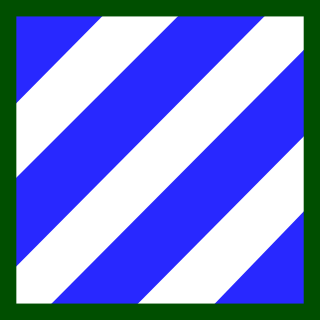
The 3rd Infantry Division is a combined arms division of the United States Army based at Fort Stewart, Georgia. It is a direct subordinate unit of the XVIII Airborne Corps and U.S. Army Forces Command. Its current organization includes a division headquarters and headquarters battalion, two armored brigade combat teams, one National Guard infantry brigade combat team, one task force battalion, one aviation brigade, a division artillery, a sustainment brigade and a combat sustainment support battalion along with a maneuver enhancement brigade. The division has a distinguished history, having seen active service in World War I, World War II, the Korean War, Vietnam War, and the Global War on Terror. The Medal of Honor has been awarded to 61 members of the 3rd Infantry Division, making the division the most honored in the Army.

V Corps, formerly known as the Fifth Corps, is a regular corps of the United States Army at Fort Knox. It was previously active during World War I, World War II, the Cold War, the Kosovo War, and the War on Terrorism.

The Army National Guard (ARNG), in conjunction with the Air National Guard, is an organized militia force and a federal military reserve force of the United States Army. They are simultaneously part of two different organizations: the Army National Guard of each state, most territories, and the District of Columbia, and the Army National Guard of the United States. The Army National Guard is divided into subordinate units stationed in each U.S. state and territory, as well as the District of Columbia, operating under their respective governors and governor-equivalents.

The United States Army Special Operations Command (Airborne) is the command charged with overseeing the various special operations forces of the United States Army. Headquartered at Fort Bragg, North Carolina, it is the largest component of the United States Special Operations Command. It is an Army Service Component Command. Its mission is to organize, train, educate, man, equip, fund, administer, mobilize, deploy and sustain Army special operations forces to successfully conduct worldwide special operations.

The 29th Infantry Division, also known as the "Blue and Gray Division", is an infantry division of the United States Army based in Fort Belvoir, Virginia. It is currently a formation of the U.S. Army National Guard and contains units from Virginia, Maryland, Kentucky, North Carolina, South Carolina and West Virginia.
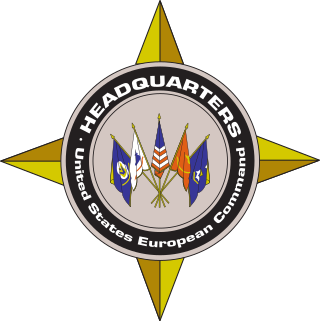
The United States European Command (EUCOM) is one of the eleven unified combatant commands of the United States military, headquartered in Stuttgart, Germany. Its area of focus covers 21,000,000 square miles (54,000,000 km2) and 51 countries and territories, including Europe, Russia, and Greenland. The Commander of the United States EUCOM simultaneously serves as the Supreme Allied Commander, Europe (SACEUR) within NATO, a military alliance. During the Gulf War and Operation Northern Watch, EUCOM controlled the forces flying from Incirlik Air Base.

United States Army Forces Command (FORSCOM) is the largest United States Army command. It provides expeditionary, regionally engaged, campaign-capable land forces to combatant commanders. Headquartered at Fort Bragg, North Carolina, FORSCOM consists of more than 750,000 active Army, U.S. Army Reserve, and Army National Guard soldiers. FORSCOM was created on 1 July 1973 from the former Continental Army Command, who in turn supplanted Army Field Forces and Army Ground Forces.

The reorganization plan of the United States Army is a current modernization (2017–2028) and reorganization (2006–2016) plan of the United States Army that was implemented (2006–2016) under the direction of Brigade Modernization Command. This effort formally began in 2006 when General Peter Schoomaker, was given the support to move the Army from its Cold War divisional orientation to a full-spectrum capability with fully manned, equipped and trained brigades; this effort was completed by the end of 2016. It has been the most comprehensive reorganization since World War II and included modular combat brigades, support brigades, and command headquarters, as well as rebalancing the active and reserve components. The plan was first proposed by the Army's 34th Chief of Staff, Eric Shinseki, in 1999, but was bitterly opposed internally by the Army.
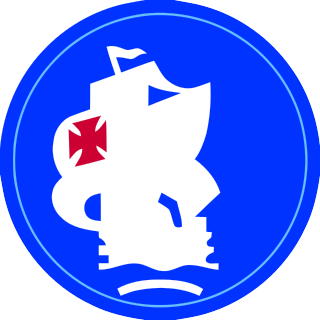
United States Army South is an Army service component command of United States Southern Command whose area of responsibility includes 31 countries and 15 areas of special sovereignty in Central and South America and the Caribbean. It is headquartered at Fort Sam Houston, Texas.
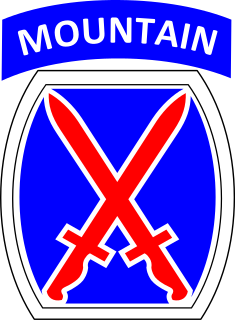
The 3rd Brigade Combat Team, 10th Mountain Division is an infantry brigade combat team of the United States Army based at Fort Polk, Louisiana. Since its activation in 2004, the brigade has deployed four times to Afghanistan in support of Operation Enduring Freedom. In 2014, the brigade inactivated at Fort Drum, NY, and its infantry battalions were reassigned to other brigades while its special troops battalion, field artillery battalion, brigade support battalion and cavalry squadron were inactivated. The brigade reactivated at Fort Polk, LA in 2015 by reflagging the assets of the 4th Brigade Combat Team, 10th Mountain Division, which was inactivated. The infantry, cavalry and field artillery battalions of the 4th Brigade were reassigned to the 3rd Brigade. The brigade deployed to Iraq in 2017 in support of Operation Inherent Resolve. Recently, the brigade deployed to the Southwest Border in 2019 in support of Operation Faithful Patriot.
The 170th Infantry Brigade was an infantry formation of the United States Army. From 2009 to 2012, as part of its third period of existence, it was based at Baumholder in the Federal Republic of Germany.
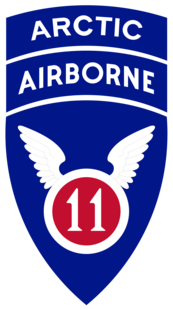
The 2nd Infantry Brigade Combat Team (Airborne), 11th Airborne Division is an airborne infantry brigade combat team (BCT) of the United States Army. The unit is stationed at Joint Base Elmendorf-Richardson in Anchorage, Alaska and is the only airborne brigade combat team in the Pacific Theater. It is also the newest airborne Infantry BCT and one of only five in the United States Army; the others are the three Infantry BCTs of the 82nd Airborne Division and the 173rd Airborne Brigade.

The structure of the United States Army is complex, and can be interpreted in several different ways: active/reserve, operational/administrative, and branches/functional areas.

United States Army Africa (USARAF), also known as the Southern European Task Force(SETAF), was the United States Army service component command of United States Africa Command.

The 97th Civil Affairs Battalion (Airborne) is a civil affairs battalion of the 95th Civil Affairs Brigade (Airborne) based at Fort Bragg, North Carolina. It is a member of the only active duty Special Operations Civil Affairs unit in the United States Department of Defense. The concept for a Civil Affairs brigade had been under consideration for years, but was finally approved as a result of the 2006 Quadrennial Defense Review.

PM WIN-T is a component of Program Executive Office Command, Control and Communications-Tactical in the United States Army. PM WIN-T has been absorbed into PM Tactical Networks as Product Manager for Mission Networks.
Train Advise Assist Command – East was a multinational military formation, part of NATO's Resolute Support Mission within Afghanistan. Until 2014 it was designated Regional Command East, part of the International Security Assistance Force (ISAF). The United States Army provided the force headquarters. The command headquarters was located in Laghman Province.
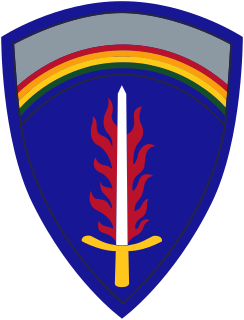
United States Army Europe and Africa (USAREUR-AF) is an Army Service Component Command (ASCC) /Theater Army responsible for directing United States Army operations throughout the U.S. European Command (EUCOM) and U.S. Africa Command (AFRICOM) area of responsibility (AOR).

The 1st Security Force Assistance Brigade is a security force assistance brigade of the United States Army. It is based in Fort Benning, Georgia and is under the command of BG Scott Jackson and Command Sergeant Major Jerry Dodson. On February 8, 2018, the 1st SFAB held its official activation ceremony at the National Infantry Museum at Fort Benning.
References
- ↑ "Defense Freedom of Information Act Policy Office (DFOIPO) - Combatant Commands". Dod.mil. Retrieved 2013-10-02.
- 1 2 "The United States Army | STAND-TO! | Regionally Aligned Forces". Army.mil. 2012-12-20. Retrieved 2013-10-02.
- ↑ Defense Security Cooperation Agency
- 1 2 3 4 5 "Regionally Aligned Forces: A New Model for Building Partnerships". Armylive.dodlive.mil. 2012-03-22. Retrieved 2013-10-02.
- ↑ "Regional alignment will include Guard, Reserve | Army Times". armytimes.com. Retrieved 2013-10-02.
- 1 2 3 4 5 6 FM 3-22 Army Support To Security Cooperation
- ↑ "New world-wide deployments: Who's going where | Army Times". armytimes.com. Retrieved 2013-10-02.
- ↑ Sustaining Global Leadership: Priorities for 21st Century Defense
- ↑ "News Article: Future Army Forces Must Be Regionally Aligned, Odierno Says". Defense.gov. Retrieved 2013-10-02.
- ↑ "10 USC § 3062 - Policy; composition; organized peace establishment | Title 10 - Armed Forces | U.S. Code | LII / Legal Information Institute". Law.cornell.edu. Retrieved 2013-10-02.
- 1 2 C. Todd Lopez. "With drawdown in Afghanistan, Army regional alignments likely to increase". Jble.af.mil. Archived from the original on 2013-10-05. Retrieved 2013-10-02.
- 1 2 Security Sector Reform
- ↑ "USASOC Home Page". Soc.mil. Archived from the original on 2013-02-13. Retrieved 2013-10-02.
- ↑ [ dead link ]
- ↑ (PDF) https://web.archive.org/web/20120321171820/http://www.soc.mil/UNS/Fact%20Sheets/USAJFKSWCS.pdf. Archived from the original (PDF) on March 21, 2012. Retrieved June 21, 2013.
{{cite web}}: Missing or empty|title=(help) - 1 2 "Uspacom". Army.mil. Retrieved 2014-07-23.
- ↑ "Second Infantry Division, U.S. Army". 2id.korea.army.mil. Archived from the original on 2013-12-06. Retrieved 2014-07-23.
- ↑ "Our Mission". 2id.korea.army.mil. Archived from the original on 2013-10-05. Retrieved 2013-10-02.
- ↑ "Twenty-fifth Infantry Division | The United States Army". Army.mil. Retrieved 2014-07-23.
- ↑ "25th Infantry Division". 25idl.army.mil. Retrieved 2013-10-02.
- 1 2 "With drawdown in Afghanistan, Army regional alignments likely to increase | Article | The United States Army". Army.mil. 2013-05-31. Retrieved 2013-10-02.
- ↑ "The United States Army | STAND-TO! | U.S. Army Brigade Support to U.S. Africa Command". Army.mil. 2012-03-22. Retrieved 2013-10-02.
- 1 2 "1st Infantry Division". Riley.army.mil. 2012-12-14. Archived from the original on March 13, 2013. Retrieved 2013-10-02.
- ↑ "The United States Army | STAND-TO! | Regionally Aligned Forces". Army.mil. 2012-12-20. Retrieved 2013-10-02.
- ↑ "Archived copy". Archived from the original on 2012-04-22. Retrieved 2014-11-23.
{{cite web}}: CS1 maint: archived copy as title (link) - ↑ "Regionally aligned forces in Europe on display during CSA visit to Combined Resolve III".
- 1 2 "1st Infantry Division". Riley.army.mil. 2013-05-14. Archived from the original on 2013-10-04. Retrieved 2013-10-02.
- ↑ https://web.archive.org/web/20130528154532/http://www.soc.mil/USASFC/USASFC%20History.html. Archived from the original on May 28, 2013. Retrieved June 21, 2013.
{{cite web}}: Missing or empty|title=(help) - ↑ "The United States Army | SWCS". Soc.mil. 2012-08-13. Retrieved 2013-10-02.
- ↑ Building the Capacity of Partner States Through Security Force Assistance
- ↑ "The United States Army | Organization". Army.mil. Retrieved 2013-10-02.
- ↑ 2012 Strategic Army Planning Guidance